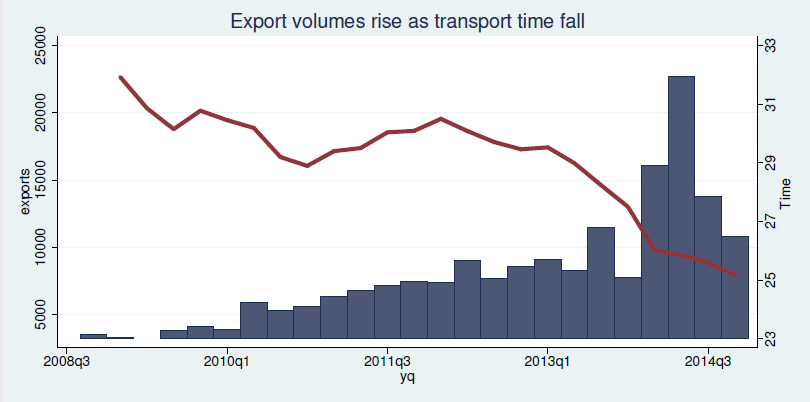
The need to prioritise export linkages in Uganda’s new growth strategy
Establishing a unit that focuses on tackling information constraints between firms, as well as a supplier database registry of domestic firms, can support export linkages in Uganda. Linking domestic tax data to such a firm registry would further enhance access to information, thereby improving export linkages and domestic firm competitiveness, in the pursuit of economic growth.
Recent export performance in Uganda has been impressive, driven by the Government of Uganda and East African Community (EAC) policy. These exporters have driven Uganda’s output and productivity growth, both directly and indirectly, through their supply-chain. The key to supporting Uganda’s growth in the future is to encourage supply-chain deepening in the domestic economy.
If targeting export linkages is the focus of Uganda’s new ‘Buy Uganda, Build Uganda’ (BUBU) and ‘Local Content’ (LC) policies then these strategies can drive growth. If these policies refocus Uganda’s growth strategy on the domestic market then they are unlikely to lead to long-term sustainable growth.
Uganda’s export performance
Over the last five years the Government and its regional partners have focused on reducing trade costs. These include one-stop border posts, removal of role-in-motion weigh bridges, removal of police check points, port upgrading, improved road surfaces, EAC Single Customs Territory, including a regional bond and interfacing of regional customs systems.
As shown by the red line in Figure 1, the time it takes to export goods from Uganda has seen a rapid decline since 2009. As a consequence of this decline, Ugandan export volumes have risen. The same effect is evident if we look at the number of exporters and the number of products exported from Uganda.

Exporters have driven Uganda’s output and productivity growth
This export growth has been extremely beneficial to the Ugandan economy. Economic research has shown that by being exposed to international competitive pressures, and with new demand for higher quality and larger markets, new exporters grow, become more productive, and invest in higher quality products (De Loecker, 2007; Bernard and Jensen, 1999; Van Biesebroeck, 2005; Bustos, 2011; Pavcnik, 2002; Kugler and Verhoogen, 2012; Lileeva and Treer, 2010).
In recent International Growth Centre (IGC) research on Uganda, (Spray, 2017) has shown that exporting leads not only to output and productivity growth for the exporting firm, but also for the new exporting firms’ direct suppliers. This suggests exporters are causing spill overs in productivity down their supply-chain. This clearly highlights why an export oriented approach to economic growth can lead to transformational growth. It also indicates that connecting domestic suppliers to exporters and other large firms can lead to substantial output and productivity growth.
Export linkages should be Uganda’s focus
Uganda’s new BUBU policy and draft LC legislation focus heavily on shifting firms away from an emphasis on international trade, towards encouraging supply for domestic consumption. This could be problematic for two main reasons: (1) Uganda’s market is small and so production for the domestic market will limit the growth potential of local firms; (2) Production for domestic consumption does not expose firms to international competitive pressures which research has shown leads to output and productivity growth. Indeed, no country has ever developed without a key focus on its international trade sector and many countries that have looked to protect local industries have instead supported expensive and inefficient industrial sectors.
Moreover, some of the proposed interventions in the BUBU policy and the LC legislation do not have a great track record when they have been implemented elsewhere. For example, as part of the LC legislation, companies will be mandated to purchase goods locally when they are available. These types of restrictions have generally been unsuccessful for two reasons. First, it is often easy to circumvent these types of policies either by providing deceptive statistics or by appealing to the lack of local capacity in a given sector.
As a consequence, these rules often have zero effect (Sutton, 2014). If they are implemented strictly there is another problem. These types of rules can lead to distortions in domestic markets such that inefficient sectors are protected at the expense of high productivity sectors. This type of policy was adopted by many Latin American countries under the rationale of Import Substitution Industrialisation (ISI). Sadly, there is little evidence that firms that received protection become internationally competitive. Instead consumers had to pay higher prices for low-quality products and firms could not access high quality inputs which in turn hurt their productivity (Baer, 1972).
Instead of focusing just on local markets, Uganda can learn from international best practice by putting in place a modern policy toolkit to encourage greater trade between international exporters and domestic firms.
Policy recommendations
The first policy suggestion is to establish a Local Content Unit (LCU) that focuses on tackling information constraints between firms. Research by Spray (2017) suggests that local suppliers can directly learn from exporters and foreign businesses and in turn grow and improve their productivity. Indeed, in most cases, foreign businesses actively seek domestic suppliers.
A LCU can encourage greater domestic trade by:
1) identifying what inputs are required by exporting firms,
2) training local firms in how to meet these demands. Professor John Sutton argues what is needed is a small, highly professional team that can liaise with multinational firms in a co-operative manner, and with a deep understanding of both (a) local capabilities, and (b) the feasible modes of engagement of local firms in supply-chains (Sutton, 2014).
The second recommendation is to consider establishing a supplier database of all firms operating in Uganda. One complaint often made by foreign businesses is that they cannot find domestically produced goods available locally. This is often simply because the firms are not well known to these business people.
One way to reduce this `information constraint' is to establish a business registry of all of the firms operating in Uganda and to make this information publicly available and searchable by business people. This has been tried in other countries and has sometimes failed due to the following reasons:
1) the database quickly goes out of date and the details of firms are not reliable;
2) the database is not easily searchable.
To avoid these problems, I suggest the following solution: Link the Uganda Revenue Authority (URA) domestic tax data to the firm registry. Using this detailed firm information, business people could get detailed information about firm transaction history, firm sales, and firm performance. This could then be used to verify firm reliability and allow foreign businesses to quickly identify high quality domestic suppliers.
References:
Baer, W. (1972). “Import substitution and industrialization in Latin America: experiences and interpretations”, Latin American Research Review.
Bernard, A. B. and Jensen, J. B. (1999). “Exceptional exporter performance: cause, effect, or both?,” Journal of international economics.
Bustos, P. (2011). "Trade Liberalization, Exports, and Technology Upgrading: Evidence on the Impact of MERCOSUR on Argentinian Firms", American Economic Review.
De Loecker, J. (20077). “Do exports generate higher productivity? Evidence from Slovenia,” Journal of international economics.
Kugler, M. and Verhoogen, E. (2012). Prices, Plant Size, and Product Quality. Oxford University Press.
Lileeva, A. and Trefler, D. (2010). “Improved Access to Foreign Markets Raises Plant-level Productivity…For Some Plants”, The Quarterly Journal of Economics, 2010, vol. 125, issue 3, 1051-1099.
Pavcnik, N. (2002). "Trade Liberalization, Exit, And Productivity Improvements: Evidence From Chilean Plants", Review of Economic Studies.
Spray. J. (2017). Export transitions, productivity, and the supply chain: Assessing the influence of EAC trade costs reductions in exports and export supply chains, International Growth Centre Working Paper, F-43404-UGA-1.
Sutton, J. (2014). “Gains from the Natural Gas: Local Content and Tanzanias Industrial Develop- ment”, The Seventh Gilman Rutihinda Memorial Lecture.
Van Biesebroeck, J. (2005). "Exporting Raises Productivity In Sub-Saharan African Manufacturing Firms," Journal of International Economics.

